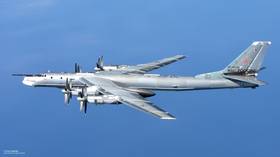
The Tu-95s did not enter American airspace, and were “not seen as a threat”

FILE PHOTO: A Russian Tu-95 Bear ‘H’ photographed from an RAF Typhoon Quick Reaction Alert aircraft (QRA) near Scotland, April 2014 © Flickr / Defence Imagery
The North American Aerospace Defense Command (NORAD) scrambled two F-16 fighter jets to “detect, track, positively identify and intercept” a pair of Russian Tu-95 long-range bombers near Alaska on Monday. The Russian planes remained in international airspace, and their activity was not seen as “provocative,” NORAD said.
The Russian bombers were tracked entering the Alaskan Air Defense Identification Zone (ADIZ), an area that the US considers vital to its national security, but extends far beyond its territorial airspace. Bordered by the Aleutian Islands to the south, the Alaskan ADIZ covers almost all of the Bering Sea.
The F-16s “intercepted” the bombers, which remained safely outside “American or Canadian sovereign airspace,” read a statement from NORAD on Tuesday.
Read more
“Russian activity in the North American ADIZ is not seen as a threat nor is the activity seen as provocative,” the statement continued. “NORAD tracks and positively identifies foreign military aircraft that enter the ADIZ. NORAD routinely monitors foreign aircraft movements and as necessary, escorts them from the ADIZ.”
Earlier, the Russian Ministry of Defense reported that two Tu-95s carried out a routine flight over neutral waters of the Pacific Ocean, as well as the Bering Sea and the Sea of Okhotsk. The maneuver lasted over 12 hours, the ministry noted.
Russia often conducts flights near US airspace, and such interactions are commonplace. NORAD tracked two Russian patrol aircraft in the Alaskan ADIZ last month. Russia monitors US and NATO flights near its own airspace too, and has sent its jets to escort American fighters and bombers away from its borders on numerous occasions in recent years.




